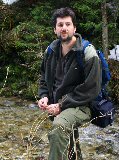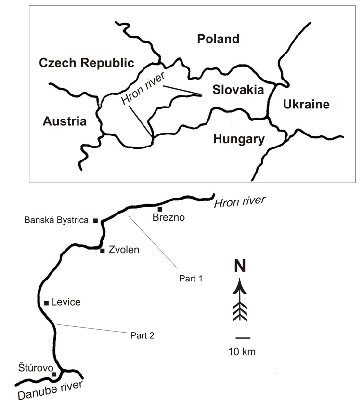IUCN/SSC Otter Specialist Group Bulletin

|
IUCN/SCC Otter Specialist Group Bulletin Volume 27 Issue 3 Pages 123- 166 (December 2010)) Citation: Urban, P., Hrivnák, R., Oťaheľová, H. and Weis, K. (2010). Aquatic Macrophyte Vegetation and its Relationship to the Occurrence of the Eurasian Otter (Lutra lutra) in the Hron River (Slovakia) . IUCN Otter Spec. Group Bull. 27 (3): 158 - 165 Aquatic Macrophyte Vegetation and its Relationship to the Occurrence of the Eurasian Otter (Lutra lutra) in the Hron River (Slovakia) Peter Urban1, Richard Hrivnák2, Helena Oťaheľová2, Karol Weis3
11Department of Biology and Ecology, Faculty of Natural Sciences, University of Matej Bel, Tajovského 40, SK-974 01 Banská Bystrica, Slovakia. e-mail: kurbanlutra@gmail.com
|


  |
| Abstract: The relationship between the presence of the otter, expressed by its sign behaviours (scent marks and spraints making) and the qualitative characteristics of aquatic macrophytes was studied in the Hron River (Slovakia). Based on macrophytes, it was possible to divide the Hron River into two sections. The upper section is relatively poor in species (species number – 3) when comparing it to the lower section (3.5). We suspect that, regarding the dominant influence of food availability, there only exists a very uncertain preference of visiting sections with a higher qualitative and quantitative representation of macrophytes in the watercourse. We found that in the lower section, that had a higher number of macrophytes, there were higher amounts of otter signs. The Hron River otter therefore seems to slightly prefer sections, which have greater macrophyte richness. However, differences in amount of otter signs between mentioned sections are relatively small and with statistically no significance. |
| Keywords: running water, aquatic plants, Lutra lutra, macrophytes-otter relationship |
| Française | Español |
INTRODUCTION
As the top predator of the trophic water chain, the Eurasian otter (Lutra lutra Linnaeus, 1758) has an important position as an keystone, umbrella and focus species of any given water ecosystems. The main ecological factor, which affects its presence in water biotopes, is sufficient food supply (e.g. Kruuk, 1995, 2006; Jendrzejewska et al., 2001; Clavero et al., 2003). Other factors such as lack of shelter have a significantly smaller influence, but, however, vegetation in the broad sense seems to be frequently studied (O’Connor et al., 1977; Jenkins and Burrows, 1980; Macdonald and Mason, 1983; Bass et al., 1984). Some studies based on spraints have pointed to the importance of the presence of trees, woodland or other cover, as well as the impact of human activities, while others have also demonstrated a relationship with food supply (Macdonald and Mason, 1983; Bas et al., 1984; Prenda and Granado-Lorencio, 1996; Chanin, 2003). Some authors observed a positive correlation between the amount of bank vegetation cover and sprainting activity over large areas (Adrián et al., 1985; MacDonald and Mason, 1985; Delibes et al., 1991; Prenda and Granado-Lorencio, 1996).
The relationship between the presence of the otter, expressed by otter sign behaviour, and the qualitative characteristics of aquatic macrophytes is a scarcely investigated topic. We believe that, due to the strong influence of food availability, otters could show a preference for visiting sections with higher qualitative and quantitative representation of macrophytes in the Hron River. It is well known that submerged macrophytes add to the physical complexity of the environment, creating habitat that algae and invertebrates may colonize and providing refuge for fishes from high flows and predators (Allan and Castillo, 2007). Therefore the sections with richer species composition and with more or less similar or greater cover of macrophytes, are more diverse and more representative of the preferred food of the otter.
The aim of this article is to examine the natural habitat of the Hron River to find out whether i) parts of the river can be classified by species composition of macrophytes, and consequently ii) to find out if the quantity of otter signs differs within various parts of the river based on the various macrophytes present.
METHODS
Study Area
The Hron River (48º 49´ 30˝ N – 19 º 00´ 50˝ E; 47 º 49´ 08˝ N – 18 º 44´ 40˝ E) is the second longest river in Slovakia (length 297.4 km; catchment area – 5464.54 km2), and is one of the most important left side tributaries of the Danube River in the country (average flow rate of 56 m3/s near its outfall into the Danube; Figure 1). The source spring of the river is situated between the Nízke Tatry and Slovenský Raj mountains in a mountain range (altitude 934 m a.s.l.) and reaches the Danube near the village of Kamenica n/Hronom (altitude 103 m a.s.l). From source to outfall, the climate along Hron changes from a moderately cool region to a warm and very dry region (Faško and Šťastný 2002, Lapin et al., 2002). The upper and middle parts of the river lies in the submontane and colline belts of the Carpathian phytogeographical region. The lower part is situated in the planare belt of the Pannonian phytogeographical region, and a major part of the river is regulated and strongly affected by human activity. As a result, the Hron River is one of the the most modified and polluted rivers in Slovakia and only the upstream reaches of the river have relatively clean water (www.shmu.sk).
 |
| Figure 1. Location of the study area (click for larger version) |
Field Sampling and Data Processing
Research on the aquatic macrophytes was begun in September 2005 and revised at the same time of year in 2009. Nineteen river sections with a standardized length of 500 m were selected with more or less regular distances between sections, and alternating sections with and without apparent industrial or agricultural influence. Each river section was divided into 5 subsections with constant length of 100 m. In each subsection, all aquatic macrophytes (bryophytes, true vascular aquatic plants and macroscopis algae as a category “filamanetous algae”) were sampled and the Plant Mass Estimate (PME) was assessed using a five-level scale (1=rare, 2=occasional, 3=frequent, 4=abundant, 5=very abundant; Kohler and Janauer, 1995). PME data were transformed into “plant quantity” using the function y=x3 (y=“plant quantity”, x=PME; cf. Kohler and Janauer, 1995). Based on the transformed Plant Mass Estimate data, Mean Mass Total (MMT; cf. Kohler and Janauer, 1995) were calculated for each river section.
We used a standard method of controlling for the presence of otter signs (spraints, scent trails and footprints) on 300 m sections to calculate any otter presence. Spraints were removed while checking each locality. This activity took place in the summer of 2009 at the 48 localities on the main river course of the Hron River (in the gradient from stream to estuary).
Differentiation of the river was decided on the basis of aquatic macrophyte datasets using CANOCO 4.5 for Windows package (ter Braak and Šmilauer, 2002). Detrended Correspondence Analysis (DCA) was used, with rare species (occurrence only in one river section: Batrachium trichophyllum (Chaix) Bosch, Lemna gibba L., L. minor L., Potamogeton trichoides Cham. et Schlechtd. and Spirodela polyrhiza (L.) Schleid.) being downweighted. The MMT index was used as a species-abundance indicator for the analysis. Quantified numbers of otter spraints for differentiated parts of river based on the above-mentioned analysis were compared using the t-test in STATISTICA software (Statsoft, 2001).
The nomenclature used in this paper follows the FishBase (Froese and Pauly, 2010).
RESULTSEleven taxa of aquatic macrophytes (including one group – filamentous algae) were found in the Hron River. Along the first DCA axis, there is an apparent shift from relatively mesotrophic species Batrachium penicillatum to eutrophic species like Ceratophyllum demersum or Potamogeton trichoides. Relatively marked variation along the second axis is affected by the position of the outlier Batrachium trichophyllum (Figure 2). Cumulative percentages of the variance of species data for the first two axes are 45 and 50, respectively. Based on macrophytes, the river was divided into two basic parts: i) an upper part from the river spring to the confluence of the Slatina and Hron Rivers near the Zvolen town (#1, Figure 1) and ii) the central and lower part from the confluence of mentioned rivers to the mouth of the Hron River to the Danube River (#2; Figure 1). Every stretch is influenced by a different macrophyte group: 1 – Batrachium penniculatum, filamentous algae and mosses Rhynchostegium riparioides, as well as partially Fontinalis antipyretica, 2 – mainly Myriophyllum spicatum, Ceratophyllum demersum and Potamogeton pectinatus. The differences between river sections are in species diversity, expressed by species number (1–3, 2–3.5), while their mean values of MMT are almost the same for both parts (1–4.54, 2–4.38).
The average amount of individual otter signs showed greater or smaller differences between the different sections (Table 1). Compared to section 2, the scent marks and spraints in section 1 have lower average values; footprints were only recorded in section 1. However, all differences between the sections are statistically insignificant (Table 1).
DISCUSSION
The results we obtained confirmed the aim of our paper as the upper section of the flow (1) with a lower macrophyte richness showed lower average values of otter signs. The lower section (2), which is richer in macrophytes also had higher values of otter signs (Table 1). The otter therefore probably slightly prefers sections with greater macrophyte richness. This difference is however, relatively small as there were no statistically significant differences. It is likely that the differences can be found in the availability of food, which is sufficient for the permanent occurrence of the otter in both sections of the river.
The main source of food for otters is fish, which differ in composition between the upper and the lower section of the river, yet species richness is similar. Typical species for the upper section are: Salmo trutta m. fario and Cottus poecilopus (mountain zone), Hucho hucho, Thymallus thymallus, Phoxinus phoxinus, Alburnoides bipunctatus, Gobio gobio, Barbus barbus, Leuciscus cephalus, Chondrostoma nasus, Barbatula barbatula, Lota lota and Cottus gobio (submountain zone), Oncorhynchus mykiss, Eudontomyzon vladykovi, Leusciscus leuciscus, Cottus poecilopus (Sedlár et al., 1983), which are also present in the lower segments of the upper section. Esox lucius, Rutilus rutilus, Scardinius erythrophthalmus, Aspius aspius, Blicca bjoerkna, Ballerus sapa, Ballerus ballerus, Carassius carassius, Cyprinus carpio, Cobitis taenia, Silurus glanis, Anguilla anguilla, Sander lucioperca, Perca fluviatis, Zingel zingel, Zingel streber, Gymnocephalus cernuus and Gymnocephalus schraetser are typical for lower section of the river. Species as Proterorhinus marmoratus, Barbatula barbatula, Carassius auratus and Misgurnus fossillis can be found in canals and river oxbows near the river mouth in the lowland belt of the lower section (Sedlár et al., 1983). The abundance and fish mass in the lowest found parameters is similar in both sections, yet the upper limit is higher in the lower section. The abundance and fish mass were 136–2882 CPUE-individual/ha/hour and 13–264 CPUE-individual/ha/hour for upper section, respectively. Whilst, the abundance and fish mass were 598–18000 CPUE-individual/ha/hour and 5.8–532 CPUE-individual/ha/hour within lower section (Mužík and Beleš, 2009). Fishes are the most important source of otter food, but there are several other sources. For example, increased preying on amphibians during their spring migration (Kožená et al., 1992; Brzezinski et al., 1993; Koščo and Korňan, 1999; Jendrzejewska et al., 2001) and respectively in the winter (Weber, 1990; Ruiz-Olmo et al., 1998) is well known. The most diverse composition of the prey and the highest rate of the non-fish consumption are usually identified in the summer (e.g. Kučerová, 1996; Hájková, 2001). In general, several studies and papers (Kruuk, 1995, 2006; Clavero et al., 2003) have demonstrated that in some areas (Scottish rivers and islands, central Europe, parts of Africa and Asia), the otter populations are limited by their food supply. Food is therefore a key resource for this species. Favourable conditions for the otter can be thus markedly affected by fluctuation in food availability. The otter is a typical food opportunist. When the relative abundance of its various food options change, depending on the character of the environment, the otter will hunt according to the frequency and availability of their prey (e.g. Chanin, 1985; Carrs, 1995).
Mutual connection between both diversity and abundance of the macrophyte vegetation and fauna throughout the different levels of the food chain, with the Eurasian otter as the top predator, can be seen from the obtained data within our paper. The results of our short study show a positive relationship (although not significant) between species richness of macrophytes and the occurrence of the European otter as demonstrated by the quantity of otter signs. In order to understand this relationship better, further studies and broader data material is required.
Acknowledgements - We thank Milan Valachovič, Petra Debnárová, Gabriela Dunajská, and Erika Urbanová for their help with the field work and Peter Bitušík for considerate comments on draft of the manuscript. This study was supported by the VEGA Grant Agency of the Slovak Republic (grant numbers 1/0836/08 and 2/5083/25).
REFERENCES
Adrián, M.I., Wilden, W., Delibes, M. (1985). Otter distribution and agriculture in southwestern Spain. Cong. Int. Un. Game Biol., Brussels, 17-th, 17-21 September 1985: 519–526.
Allan J.D., Castillo, M.M. (2007). Stream Ecology. Structure and function of running waters. 2nd Edition. Springer, Dordrecht, 436 pp.
Bas, N., Jenkins, D., Rothery, P. (1984). Ecology of otters in northern Scotland. The distribution of otter (Lutra lutra) faeces in relation to bankside vegetation on the river Dee in summer 1981. J. Appl. Ecol. 21: 507-513.
Brzezinski, M., Jendrzejewski, W., Jendrzejewska, B. (1993). Diet of otters (Lutra lutra) inhabiting small rivers in the Białowieża National Park, Eastern Poland. J. Zoology 230: 495-501.
Carrs, D. N. (1995). Foraging behaviour and feeding ecology of the otter Lutra lutra: a selective review. Hystrix 7: 179-194.
Chanin, P. (1985). The Natural History of Otters. Croom Helm, Kent, 179 pp.
Chanin, P. (2003). Ecology of the European Otter. Conserving Natura 2000 Rivers Ecology Series No. 10. English Nature, Peterborough.
Clavero, M., Prenda, J., Delibes, M. (2003). Trophic diversity of the otter (Lutra lutra L.) in temperate and Mediterranean freshwater habitats. J. Biogeogr. 30: 761-769.
Delibes, M., MacDonald, S.M., Mason, C.F. (1991). Seasonal marking, habitat and organochlorine contamination in otters (Lutra lutra): a comparison between catchments in Andalucia and Wales. Mammalia 55: 567-578.
Faško, P., Šťastný, P. (2002). Mean Annual Precipitation Totals. In: Miklós, L. (Ed.). Landscape Atlas of the Slovak Republic. 1st ed. Ministry of Environment Slovak Republic, Bratislava, Map No. 54.
Froese, R., Pauly D. (Editors) (2010). FishBase. World Wide Web electronic publication. www.fishbase.org, [accessed 11/2010].
Hájková, P. (2001). Potravná ekológia vydry riečnej (Lutra lutra) v hornej časti povodia Hornádu. Diplomová práca. Prírodovedecká fakulta, Univerzita Komenského, Bratislava. 53 pp. + prílohy. (msc.). [Depon. In: Prírodovedecká fakulta, Univerzita Komenského, Bratislava].
Jendrzejewska, B., Sidorovich, V.E., Pikulik, M.M., Jendrzejewski, W. (2001). Feeding habits of the otter and the american mink in Bialowieza Primewal Forest (Poland) compared to the Eurasian populations. Ecography 24: 165-180.
Jenkins, D., Burrows, G.O. (1980). Ecology of otters in northern Scotland, III. The use of faeces as indicators of otter (Lutra lutra) density and distribution. J. Anim. Ecol. 49: 755-774.
Kohler, A., Janauer, G.A. (1995). Zur Methodik der Untersuchungen von aquatischen Makrophyten in Fließgewässern. In: Steinberg, Ch., Bernhardt, H., Klapper, H. (Eds). Handbuch Angewandte Limnologie. Ecomed Verlag, Lansberg/Lech, pp. 1-22.
Koščo J., Korňan, J. (1999). Potravná ekológia vydry riečnej (Lutra lutra) CHKO Kysuce. Lynx 30: 69-75.
Kožená, I., Urban, P., Štouračová, I., Mazur, I. (1992). The diet of otter Lutra lutra in the Poľana protected landscape region. Folia Zoologica 41(2): 107-122.
Kruuk, H. (1995). Wild Otters. Predation and Population. Oxford university press, Oxford, New York, Tokyo.
Kruuk, H. (2006). Otters: ecology, behaviour and conservation. Oxford University Press. Oxford.
Kučerová, M. (1996). Economic damages caused by otters. In: Dulfer R., Roche K. (Eds). First phase report of the Třeboň Otter Project. Nat. Environm. 93: 97-103.
Lapin, M., Faško, P., Melo, M., Štastný, P., Tomlain, J. (2002). Climatic districts In: Miklóš, L. (Ed.). Landscape Atlas of the Slovak Republic. 1st ed. Ministry of Environment Slovak Republic, Bratislava, Map No. 27.
Macdonald, S. M., Mason, C.F. (1983). Some factors influencing the distribution of otters (Lutra lutra). Mammal. Review 13: 1-10.
Macdonald, S.M., Mason, C.F. (1985). Otters, their habitat and conservation in Northeast Greece. Biol. Conserv. 31: 191-210.
Mužík, V., Beleš, P. (2009). Ichtyofauna stredného toku Hrona v úseku Žiar nad Hronom. [cit. 20. apríla 2010], Available at: [http://www.rybybb.sk/ichtyologia/SPRAVA_Muzik2009.pdf]
O'Connor, F. B., Sands, T.S., Barwick, D., Chanin, P., Frazer, J.F.D., Jefferies, D.J., Jenkins, D., Neal, E. (1977). Otters 1977. The report of the Joint Otter Group. Nature Conservancy Council, London.
Prenda, J., Granado-Lorencio, C. (1996). The relative influence of riparian habitat structure and fish availability on otter Lutra lutra L: sprainting activity in a small Mediterranean catchment. Biol. Conserv. 76: 9-15.
Ruiz-Olmo, J., Jiménez, J., Margalida, A. (1998). Capture and consumption of prey of the otter (Lutra lutra) in Mediterranean freshwater habitats of the Iberian peninsulla. Galemys 10: 209-226.
Sedlár, J., Straňai, I., Makara, A. (1983). Súčasný stav zarybnenia povodia Hrona. Poľnohospodárstvo 29(6): 515–524; (7): 619–627; (8): 684-701.
StatSoft (2001). STATISTICA. System reference. StatSoft Inc., Tulsa.
ter Braak, C.J.F., Šmilauer, P. (2002). CANOCO Reference manual and CanoDraw for Windows User's guide. Software for Canonical Community Ordination (version 4.5). Microcomputer Power, Ithaca, NY.
Weber, D. (1990). Das Ende des Fischotters in der Schweiz. Schriftenreihe Umwelt 128: 1-103.
Résumé : Relation entre Macrophytes Aquatiques et Presence de la Loutre d’Europe (Lutra lutra) sur la Riviere Hron (Slovaquie)
La relation entre la présence de la Loutre et les caractéristiques des macrophytes aquatiques, exprimée grâce au comportement de marquage territorial (marques olfactives et dépôts d’épreintes), a été étudiée sur la rivière Hron (Slovaquie). A partir des macrophytes, il a été possible de diviser la rivière Hron en deux sections. La partie supérieure est relativement pauvre en espèces (n=3) comparée à la partie inférieure (n=3,5). Nous supposons que vue l'importante influence de la disponibilité alimentaire sur la fréquentation de sites par la Loutre, la présence en abondance et en qualité des macrophytes n’a que peu d’impact sur la visite de sites. Nous avons constaté que dans la partie inférieure de la rivière où les macrophytes sont les plus nombreux, les signes de présence de la Loutre sont plus importants. La Loutre sur la rivière Hron semble donc préférer un peu plus les sections qui ont une plus grande richesse en macrophytes. Quoi qu’il en soit, le nombre d’indices relevés entre les deux sections étudiées est trop faible et ne présente aucune différence significative.
Revenez au dessus
Resumen: Vegetacion Macrofita Acuatica en el Rio Hron (Eslovaquia) y su Relacion con la Ocurrencia del Nutria Eurasiatica (Lutra lutra)
La relación entre la presencia de nutria, expresada por sus señas de comportamiento (marcas de olor y héces), y las características cualitativas de las especies macrófitas acuáticas fue estudiada en el río Hron (República de Eslovaquia). Basada en las macrofitas, fue posible dividir el río en dos secciones. La sección superior es relativamente pobre en especies (“species number”= 3) comparada con la sección inferior (3.5). Sospechamos que, dada la influencia dominante que ejerce la disponibilidad de alimento; la preferencia por visitar seciones del río con una representacion alta de macrófitas en calidad y cantidad, se hace incierta. En la sección inferior del río, con mayor número de macrófitas, se encotraron mayor cantidad de signos de nutria. Por lo tanto, la nutria del río Hron pareciera preferir secciones con mayor riqueza en macrófitas. Sin embargo, las diferencias entre los signos de nutrias entre las mencionadas secciones es relativamente pequeña y sin significado estadístico.
Vuelva a la tapa
